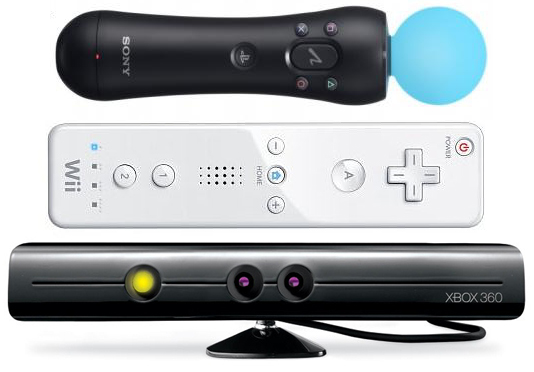What happened to the promises of motion gaming?
I once was over at a friend’s house and watched him play Red Steel 2. Switching between swinging his sword and shooting his gun, after about an hour or so, he began to breath slightly heavier and sweat a little, the exaggerated movements for attacking making him grow weary. Understandable, as the Wii’s emphasis on motion is geared towards physical activity, as evidenced by WiiFit and WiiSports. And yet, after playing Legends of Zelda: Twilight Princess and Okami for hours at a time, I haven’t even begun to experience any type of exertion. Our setups are similar – we’re both seated 6-10 feet from the screen. I wondered then if he purposely developed more aggressive movements because he wanted to (subconsciously) exercise, while I’m content with low-key, flick-of-the-wrist movements, both of which are registered by the motion sensor exactly the same. In other words, I treat my Wiimote like a controller with an extra “motion button,” while my friend sees it as the physical manifestation of striking as Miyamoto probably hoped.
Either way, it’s difficult to think that motion gaming is actually moving in an interesting or innovating direction. We all considered motion gaming a gimmick when the Wii was first announced – but what we have now is worse, or more accurately, disappointing. The burden of proof was on Nintendo (and then with Microsoft’s Kinect and Sony’s Move) to show us something; if the recent E3 was anything, it showed that everyone dropped the ball.
Police 911 was the best thing that motion gaming came up with – a lavishly expensive arcade game pretty much only available at Dave and Busters. Motion gaming seemed to be a way to interact with the environment in ways that kept us up and on our toes in the heat of the moment; but it ended up being used for mini-games, light exercise, and quiet moments of stationary, semi-pinpoint aiming. We’ll never get that sword fighting/lightsaber game we dreamed of, and driving games without the tension of a real wheel is endearingly hopeless. Motion controls are inherently limiting, more so than I think any of us, even the programmers, really expected it to be. Gaming is about timing, accuracy, and precision, all things that motion controls inherently lack. The games themselves are designed to compensate for that (larger reticules, wider hit detection), and isn’t that exactly what motion controls were trying to avoid?
The larger problem was inferred from E3 and the wildly divergent (yet more of the same) games and features announced. Microsoft went heavy and hard with simultaneous multimedia venues, Sony essentially copied Nintendo’s ideas from seven years ago, and Nintendo rapped our knuckles like a college professor, teaching us how to play video games and giving us homework assignments on their website. The biggest draws were South Park’s The Stick of Truth (which had nothing to do with motion) and Ubisoft’s ZombiU, an intriguingly potential use of the new WiiU controller which still left me somewhat skeptical (and, hey, look, we’re back to zombies again). But what about those motion controls? The great pioneers of the technology even seemed to brush them off, like they ain’t no thing.
Motion controls can be simple (bowling a Wii ball) or complex (the bizarre way to help someone fish in Okami), but there’s no draw between the two, which prevents casual gamers becoming core gamers. Nothing is wrong with either group, but it’s no surprise that the WiiU so dropped early, since the casual market had no interest in exploring games beyond those simple, crowd pleasing ones; they simply are not going to go from Just Dance to No More Heroes; the furthest they’ll get is Mario Party (insert number here). So Nintendo decided to move on to the next “era” of consoles for casuals can easily play instead of pushing the capability of motion with the current gen. This not only leaves core gamers with more of the same, but does nothing to advance motion gaming as a real, potential method of entertainment. Somewhere, Milo is crying himself to digital sleep.
So, where are we at in the realm over motion gaming? If the WiiU is any indication, we’re looking a 360-degree digital landscape, a world that seems extremely vast to look at, but empty on the outskirts with no fertile soil to grow. Oh, well. There’s always zombies.

Comments are closed